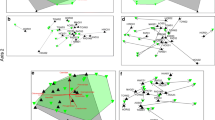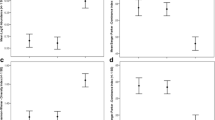Abstract
Dipnet (DN) sampling is routinely employed for macroinvertebrate bioassessments in wetlands, but it has been demonstrated that some taxa are more effectively collected with activity traps (AT). The Minnesota Pollution Control Agency (MPCA) used both DN and AT methods to evaluate the biological condition of depressional wetlands in the Mixed Wood Plains (MWP) and Temperate Prairies (TP) ecoregions. Two indices of biotic integrity (IBIs) were developed for each ecoregion using: 1) DN data alone and 2) composite samples consisting of both DN and AT data. ATs collected more active taxa such as diving beetles and swimming Hemiptera. DNs collected more taxa and collected more skating taxa and those associated with sediment or vegetation. A comparison of the effectiveness of the IBIs to evaluate biological condition indicated that the composite data had a slightly better relationship with anthropogenic disturbance and was marginally more precise. A comparison of sampling and processing costs revealed that sampling using composite samples was 130 % greater and processing was 50 % greater compared to DN-only samples. Based on the cost and limited benefit of adding AT samples, a DN-only sampling protocol is recommended to assess biological condition in depressional wetlands.




Similar content being viewed by others
References
Batzer DP, Shurtleff AS, Rader RB (2001) Sampling invertebrates in wetlands. In: Rader RB, Batzer DP, Wissinger SA (eds) Bioassessment and management of North American freshwater wetlands. Wiley, New York, pp 339–354
Becerra Jurado G, Masterson M, Harrington R, Kelly-Quinn M (2008) Evaluation of sampling methods for macroinvertebrate biodiversity estimation in heavily vegetated ponds. Hydrobiologia 597:97–107
Benke AC, Ward GM, Richardson TD (1999) Beaver-impounded wetlands of the southeastern coastal plain: habitat-specific composition and dynamics of invertebrates. In: Batzer DP, Rader RB, Wissinger SA (eds) Invertebrates in freshwater wetlands of North America: ecology and management. Wiley, New York, pp 217–246
Brinkman M, Duffy W (1996) Evaluation of four wetland aquatic invertebrate samplers and four sample sorting methods. J Freshw Ecol 11:193–200
Burton T, Uzarski D, Gathman J, Genet J, Keas B, Stricker C (1999) Development of a preliminary invertebrate index of biotic integrity for Lake Huron coastal wetlands. Wetlands 19:869–882
Cheal F, Davis J, Growns J, Bradley J, Whittles F (1993) The influence of sampling method on the classification of wetland macroinvertebrate communities. Hydrobiologia 257:47–56
Clarke AH (1981) The freshwater mollusks of Canada. National Museum of Natural Sciences. Ottawa, Canada
Elmberg J, Nummi P, Pöysä H, Sjöerg K (1992) Do intruding predators and trap position affect the reliability of catches in activity traps? Hydrobiologia 239:187–193
Fore LS, Frydenborg R, Miller D, Frick T, Whiting D, Espy J, Wolfe L (2007) Development and testing of biomonitoring tools for macroinvertebrates in Florida streams. Florida department of environmental protection. Tallahassee, Florida
Genet J, Bourdaghs M (2006) Development and validation of indices of biological integrity (IBI) for depressional wetlands in the temperate prairies ecoregion. Minnesota Pollution Control Agency, St. Paul
Genet, JA, Gernes MC, Markus H (2004) Defining wetland condition assessment processes. Minnesota Pollution Control Agency, St Paul, MN, USA, Final Report to U.S. Environmental Protection Agency CD975938-01
Genet J, Olsen A (2008) Assessing depressional wetland quantity and quality using a probabilistic sampling design in the Redwood River watershed, Minnesota, USA. Wetlands 28:324–335
Gernes M, Helgen J (2002) Indexes of biological integrity (IBI) for large depressional wetlands in Minnesota. Minnesota Pollution Control Agency, St. Paul
Hanson M, Roy C, Euliss N, Zimmer K, Riggs M, Butler M (2000) A surface-associated activity trap for capturing water-surface and aquatic invertebrates in wetlands. Wetlands 20:205–212
Helgen JC, Gernes MC (2001) Monitoring the condition of wetlands: indexes of biological integrity using invertebrates and vegetation. In: Batzer DP, Rader RB, Wissinger SA (eds) Invertebrates in freshwater wetlands of North America: ecology and management. Wiley, New York, pp 167–185
Helgen JC (2002) Methods for evaluating wetland condition: developing an invertebrate index of biological integrity for wetlands. US Environmental Protection Agency, Office of Water, Washington, DC
Hilsenhoff WL (1987) Effectiveness of bottle traps for collecting Dytiscidae (Coleoptera). Coleopt Bull 41:377–380
Hilsenhoff WL (1991) Comparison of bottle traps with a d-frame net for collecting adults and larvae of Dytiscidae and Hydrophilidae (Coleoptera). Coleopt Bull 45:143–146
Hilsenhoff WL (1995) Aquatic insects of wisconsin: keys to wisconsin genera and notes on biology, habitat, distribution, and species. natural history museums council university of wisconsin-madison. Madison, WI
Hilsenhoff WL, Tracy BH (1985) Techniques for collecting water beetles from lentic habitats. Proc Acad Natl Sci Phila 137:8–11
Hyvönen T, Nummi P (2000) Activity traps and the corer: complementary methods for sampling aquatic invertebrates. Hydrobiologia 432:121–125
Klečka J, Boukal D (2010) Lazy ecologist’s guide to water beetle diversity: which sampling methods are the best? Ecol Indic 11:500–508
Klemm D (1991) Taxonomy and pollution ecology of the Great Lakes region leeches (Annelida: Hirudinea). Mich Academician 24:37–103
Klemm DJ (ed) (1985) A guide to the freshwater annelida (Polychaeta, naidid, and tubificid Oligochaeta, and Hirudinea) of North America. Kendall/Hunt, Dubuque
Larson DJ, Alarie Y, Roughley RE (2000) Predaceous diving beetles (Coleoptera: Dytiscidae) of the nearctic region, with emphasis on the fauna of Canada and alaska. national research council of canada research press. Ottawa, Ontario
Merritt RW, Cummins KW (1996) An introduction to the aquatic insects of North America, 3rd edn. Kendall/Hunt, Dubuque
Merritt RW, Cummins KW, Berg MB (eds) (2008) An introduction to the aquatic insects of North America, 4th edn. Iowa, Kendall/Hunt, Dubuque
Meyer CK, Peterson SD, Whiles MR (2011) Quantitative assessment of yield, precision, and cost-effectiveness of three wetland invertebrate sampling techniques. Wetlands 31:101–112
Meyer MD, Davis CA, Bidwell JR (2013) Assessment of two methods for sampling invertebrates in shallow vegetated wetlands. Wetlands 33:1063–1073
Murkin H, Abbott P, Kadlec J (1983) A comparison of activity traps and sweep nets for sampling nektonic invertebrates in wetlands. Freshw Invertebr Biol 2:99–106
Needham J (1924) Observations of the life of the ponds at the head of Laguna Canyon. Journal of Entomology and Zoology (Pomona College, Claremont, California) 16:1-12
Nilsson A, Elmberg J, Sjoberg K (1994) Abundance and species richness patterns of predaceous diving beetles (Coleoptera, Dytiscidae) in Swedish lakes. J Biogeogr 21:197–206
O’Connor Á, Bradish S, Reed T, Moran J, Regan E, Visser M, Gormally M, Skeffington M (2004) A comparison of the efficacy of pond-net and box sampling methods in turloughs - Irish ephemeral aquatic systems. Hydrobiologia 524:133–144
Omernik JM (1987) Ecoregions of the conterminous United States. Ann Assoc Am Geogr 77:118–125
Development Core Team R (2009) R: A language and environment for statistical computing. R Foundation for Statistical Computing, Vienna
Rader RB (1999) The Florida Everglades: natural variability, invertebrate diversity, and foodweb stability. In: Batzer DP, Rader RB, Wissinger SA (eds) Invertebrates in freshwater wetlands of North America: ecology and management. Wiley, New York, pp 25–54
Smith DG (2001) Pennak’s freshwater invertebrates of the United States, 4th edn. Wiley, New York
Swanson G (1978) Funnel trap for collecting littoral aquatic invertebrates. Progress Fish Cult 40:73–73
Software S (2009) Systat for windows. Systat Software. Inc., Chicago
Software S (2011) Sigmaplot for windows. Illinois, Chicago
Turner AM, Trexler JC (1997) Sampling aquatic invertebrates from marshes: evaluating the options. J N Am Benthol Soc 16:694–709
Uzarski D, Burton T, Genet J (2004) Validation and performance of an invertebrate index of biotic integrity for Lakes Huron and Michigan fringing wetlands during a period of lake level decline. Aquat Ecosyst Health Manag 7:269–288
Verdonschot R (2010) Optimizing the use of activity traps for aquatic biodiversity studies. J N Am Benthol Soc 29:1228–1240
Whiteside M, Lindegaard C (1980) Complementary procedures for sampling small benthic invertebrates. Oikos 35:317–320
Wilcox D, Meeker J, Hudson P, Armitage B, Black M, Uzarski D (2002) Hydrologic variability and the application of index of biotic integrity metrics to wetlands: a Great Lakes evaluation. Wetlands 22:588–615
Acknowledgments
Field assistance was provided by Judy Helgen, Harold Wiegner, and many student interns. Mark Gernes, Michael Bourdaghs, Dan Helwig, Len Ferrington, Claire Serieyssol, Adam Sealock, and Moriya Rufer provided valuable input during the development of this project. We would like to thank our anonymous reviewers for their helpful comments. Funding for the development of macroinvertebrate IBIs was provided by Clean Water Act Section 104 (b) (3) Wetland Program Development Grants (#CD-995,525-01 & #CD-975,768-01).
Author information
Authors and Affiliations
Corresponding author
Rights and permissions
About this article
Cite this article
Bouchard, R.W., Genet, J.A. & Chirhart, J.W. Does Supplementing Dipnet Samples with Activity Traps Improve the Ability to Assess the Biological Integrity of Macroinvertebrate Communities in Depressional Wetlands?. Wetlands 34, 699–711 (2014). https://doi.org/10.1007/s13157-014-0535-0
Received:
Accepted:
Published:
Issue Date:
DOI: https://doi.org/10.1007/s13157-014-0535-0




